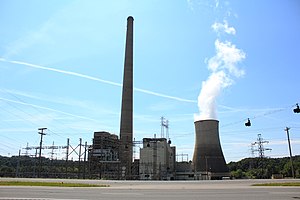| Big Sandy Power Plant | |
|---|---|
 Big Sandy Power Plant after its conversion to natural gas Big Sandy Power Plant after its conversion to natural gas | |
| Country | United States |
| Location | Lawrence County, near Louisa, Kentucky |
| Coordinates | 38°10′20″N 82°37′03″W / 38.17222°N 82.61750°W / 38.17222; -82.61750 |
| Status | Operational |
| Commission date | Unit 1: 1963 Unit 2: 1969 |
| Decommission date | Unit 2: 2015 |
| Owner | Kentucky Power Company |
| Thermal power station | |
| Primary fuel | Natural gas |
| Cooling source | Big Sandy River |
| Power generation | |
| Nameplate capacity | 1,097 MW |
| External links | |
| Commons | Related media on Commons |
| [edit on Wikidata] | |
The Big Sandy Power Plant is a 268 megawatt (MW), natural gas power plant owned and operated by Kentucky Power Company, a subsidiary of American Electric Power (AEP), on the shores of the Big Sandy River near Louisa, Kentucky. It was established in 1963. It was formerly a coal-fired power plant, but was converted to natural gas in 2016.
Plant Data
- Number of Employees: 135
- Customers: 175,000+
Emissions Data
- 2006 CO2 Emissions: 6,830,275 tons
- 2006 SO2 Emissions: 46,476 tons
- 2006 SO2 Emissions per MWh:
- 2006 NOx Emissions: 13,851 tons
- 2005 Mercury Emissions: 281 lb.
In January 2009, Sue Sturgis of the Institute of Southern Studies compiled a list of the 100 most polluting coal plants in the United States in terms of Coal Combustion Waste (CCW) stored in surface impoundments like the one involved in the TVA Kingston Fossil Plant coal ash spill. The data came from the EPA's Toxics Release Inventory (TRI) for 2006, the most recent year available.
Big Sandy Plant ranked number 40 on the list, with 915,079 pounds of coal combustion waste released to surface impoundments in 2006.
Big Sandy Plant's Fly Ash surface impoundment is on the EPA's official June 2009 list of Coal Combustion Residue (CCR) Surface Impoundments with High Hazard Potential Ratings. The rating applies to sites at which a dam failure would most likely cause loss of human life, but does not assess of the likelihood of such an event.
The data came from the EPA's Toxics Release Inventory (TRI) for 2006, the most recent year available.
Conversion to natural gas
In 2011, Big Sandy's owner AEP announced plans to switch from coal to natural gas to reduce fuel costs, greenhouse gas emissions, and airborne toxins. In 2012, AEP proposed a billion dollar upgrade to allow it to continue to burn coal and asked Kentucky regulators to approve a 30 percent increase in electricity rates to pay for the work.
Conversion to natural gas was completed on May 30, 2016. The station's Unit 2 cooling tower was demolished via implosion on September 24, 2016.
References
- ^ Big Sandy Power Plant Monitors Real Time Operations Using High-Speed Internet Connection Archived 2011-07-25 at the Wayback Machine Retrieved on 2010-11-26
- ^ Sue Sturgis, "Coal's ticking timebomb: Could disaster strike a coal ash dump near you?," Archived 2011-09-27 at the Wayback Machine Institute for Southern Studies, January 4, 2009.
- ^ TRI Explorer, EPA, accessed January 2009.
- New York Times, By ERIC LIPTON, Published: May 29, 2012: Even in Coal Country, the Fight for an Industry
- "Big Sandy Natural Gas Conversion Project Completed". Power Engineering. June 27, 2016. Retrieved November 12, 2016.
- "Big bang at Big Sandy Plant as Unit 2 comes tumbling down". dailyindependent.com. September 24, 2016. Retrieved September 24, 2016.
External links
- Existing Electric Generating Units in the United States, 2005, Energy Information Administration, accessed January 2009.
- Environmental Integrity Project, "Dirty Kilowatts: America's Most Polluting Power Plants", July 2007.
- Facility Registry System, U.S. Environmental Protection Agency, accessed January 2009.
- Energy infrastructure completed in 1963
- Energy infrastructure completed in 1969
- Buildings and structures in Lawrence County, Kentucky
- 1963 establishments in Kentucky
- Natural gas-fired power stations in Kentucky
- Former coal-fired power stations in the United States
- American Electric Power
- Big Sandy River (Ohio River tributary)